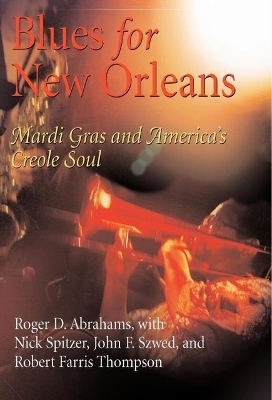
Blues for New Orleans
University of Pennsylvania Press (Verlag)
978-0-8122-3959-1 (ISBN)
- Lieferbar (Termin unbekannt)
- Versandkostenfrei
- Auch auf Rechnung
- Artikel merken
In the aftermath of Hurricane Katrina, as the citizens of New Orleans regroup and put down roots elsewhere, many wonder what will become of one of the nation's most complex creole cultures. New Orleans emerged like Atlantis from under the sea, as the city in which some of the most important American vernacular arts took shape. Creativity fostered jazz music, made of old parts and put together in utterly new ways; architecture that commingled Norman rooflines, West African floor plans, and native materials of mud and moss; food that simmered African ingredients in French sauces with Native American delicacies. There is no more powerful celebration of this happy gumbo of life in New Orleans than Mardi Gras. In Carnival, music is celebrated along the city's spiderweb grid of streets, as all classes and cultures gather for a festival that is organized and chaotic, individual and collective, accepted and licentious, sacred and profane.
The authors, distinguished writers who have long engaged with pluralized forms of American culture, begin and end in New Orleans—the city that was, the city that is, and the city that will be—but traverse geographically to Mardi Gras in the Louisiana Parishes, the Carnival in the West Indies and beyond, to Rio, Buenos Aires, even Philadelphia and Albany. Mardi Gras, they argue, must be understood in terms of the Black Atlantic complex, demonstrating how the music, dance, and festive displays of Carnival in the Greater Caribbean follow the same patterns of performance through conflict, resistance, as well as open celebration.
After the deluge and the finger pointing, how will Carnival be changed? Will the groups decamp to other Gulf Coast or Deep South locations? Or will they use the occasion to return to and express a revival of community life in New Orleans? Two things are certain: Katrina is sure to be satirized as villainess, bimbo, or symbol of mythological flood, and political leaders at all levels will undoubtedly be taken to task. The authors argue that the return of Mardi Gras will be a powerful symbol of the region's return to vitality and its ability to express and celebrate itself.
Roger D. Abrahams is Hum Rosen Professor of Humanities Emeritus at the University of Pennsylvania. He is the author and editor of many books, including After Africa (with John F. Szwed), African Folktales: Traditional Stories of the Black World, and Everyday Life: A Poetics of Vernacular Practice, also available from the University of Pennsylvania Press. Nick Spitzer is Professor of Folklore and Cultural Conservation at the University of New Orleans and host of NPR's American Routes. John F. Szwed is John M. Musser Professor of Anthropology and African American Studies at Yale University. Among his numerous books are So What: The Life of Miles Davis, Space Is the Place: The Lives and Times of Sun Ra, and Crossovers: Essays on Race, Music, and American Culture, also available from the University of Pennsylvania Press. Robert Farris Thompson is Colonel John Trumbull Professor of the History of Art at Yale University. He is the author of Flash of the Spirit: African and Afro-American Art and Philosophy and Face of the Gods: Art and Altars of Africa and the African Americas.
| Erscheint lt. Verlag | 9.3.2006 |
|---|---|
| Reihe/Serie | The City in the Twenty-First Century |
| Co-Autor | Nick Spitzer, Nick Spitzer, John F. Szwed, John F. Szwed |
| Verlagsort | Pennsylvania |
| Sprache | englisch |
| Maße | 140 x 216 mm |
| Themenwelt | Sozialwissenschaften ► Soziologie |
| ISBN-10 | 0-8122-3959-8 / 0812239598 |
| ISBN-13 | 978-0-8122-3959-1 / 9780812239591 |
| Zustand | Neuware |
| Haben Sie eine Frage zum Produkt? |
aus dem Bereich


